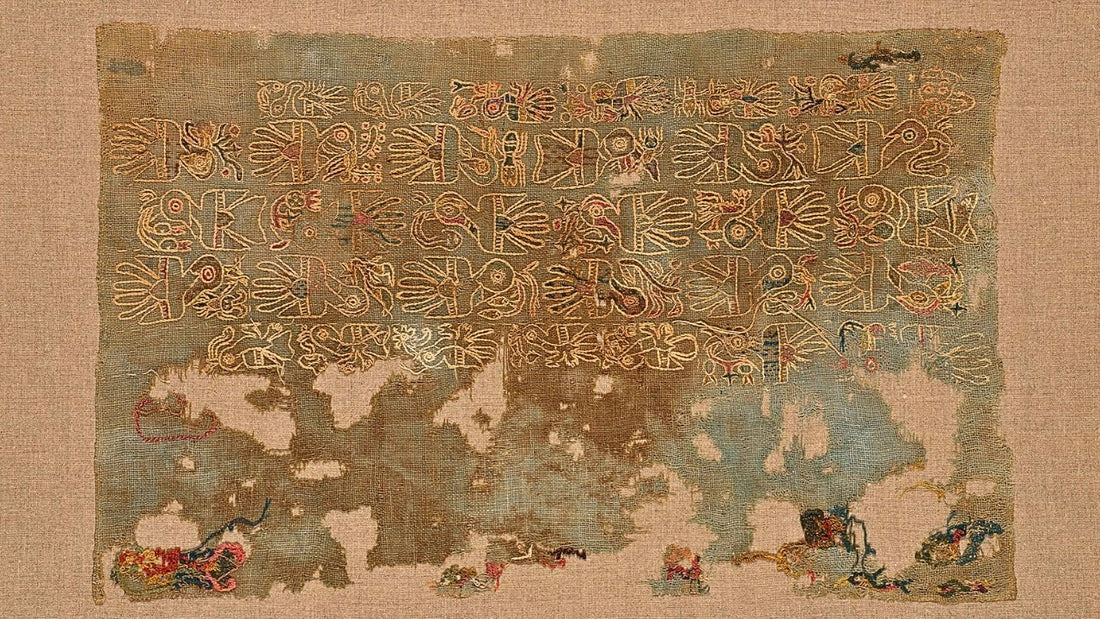
The World’s Oldest Samplers Aren’t European - They’re Nazca!
Long before alphabets, verses, and tidy border rows appeared on European “schoolgirl” samplers, needleworkers on Peru’s south coast were already stitching sprawling spot samplers, basically cloth “sketch-pads” dense with tiny birds, plants, and supernatural beings. Today, the oldest surviving examples live not in a lace covered European cabinet but in American museums, led by a monumental panel at The Met in New York. Scholars widely regard these Nazca works (ca. 200 BCE–200 CE) as the earliest sampler-type textiles known to survive.
Who were the Nazca?
The Nazca flourished on Peru’s arid south coast from roughly 200 BCE to 650 CE, celebrated for polychrome pottery, extraordinary textiles, and the vast desert geoglyphs known as the Nazca Lines.

What I mean by “sampler” in this context
Modern samplers often record alphabets and borders in orderly bands, even the spot samplers are often more "organized" i.e. the 17th century sampler below. The Nazca pieces are different: they are spot samplers, but more like large cloths where motifs and stitches are tested in no fixed order, more similar to a designer’s working page than a finished display. The term is anachronistic but useful; museum records and textile historians use “sampler” or “sample” to signal that experimental, reference-panel function.

17th century English Spot sampler MET

The must-see Nazca samplers
1) The Metropolitan Museum of Art (New York)
Title: Sampler (Nazca) Image 1
Date: 2nd century BCE
Materials: Cotton ground; embroidery in camelid hair
Size: 72.1 × 105.7 cm (28 ⅜ × 41 ⅝ in.)
Why it matters: This vast “spot” sampler worked with dozens of discrete motifs anchors the case that sampler-type textiles began in the ancient Andes.
2) The Art Institute of Chicago (Below)
Title: Sampler (Nazca)
Date: 1–200 CE
Technique: Cotton plain weave embroidered with cotton and camelid wool in back, cross, double-running, running, satin, and stem stitches
Why it matters: A brilliant overview of Nazca stitch vocabulary, with small white-outlined birds, motifs Nazca artists also loved in ceramics.

Nazca sampler, 1–200 CE (Art Institute of Chicago). Bird miniatures parade across the panel, each a tidy exercise in stitch, outline, and color.
3) The Brooklyn Museum (two additional panels) NO images and not on display.
(I requested images and will add them if granted)
Titles: Sampler with Embroidery (2007.53.3) and Sampler with Embroidered Designs (2007.53.4)
Dates: 200–600 CE
Materials: Cotton with alpaca/camelid fibers
Why they matter: These confirm that sampler-like reference panels were an ongoing Nazca practice into the Early Intermediate Period.

Are there any older samplers anywhere?
Short answer: No earlier surviving sampler-type textiles are documented by major museums or the textile scholarship surveyed here. The next-oldest “sampler” fragments often cited are Coptic (Egypt) from roughly the 4th–5th centuries CE several hundred years later than the Nazca works. (These Coptic pieces are typically pattern-darned or double-running motifs on linen.)
Elaborately embroidered Andean textiles older than the Met’s Nazca sampler do exist (think Paracas borders and mantle fragments from the 4th–3rd centuries BCE), but they are finished garment elements, not experimental panels functionally akin to samplers.
Why Nazca samplers matter
They rewrite sampler history. The Nazca panels push the practice of recording stitches and motifs over a millennium earlier than Europe’s samplers.
They reveal technique, not just iconography. Nazca embroiderers worked an impressive range back, cross, double-running, satin, stem on cotton grounds with brilliantly dyed camelid fibers.
They connect cloth to culture. Many Nazca sampler motifs (birds, plants, mythic beings) echo imagery on Nazca ceramics and relate to larger ritual textiles.
I hope you enjoyed this brief adventure into South America!
In every stitch, samplers bind us, not only across the world, but across the centuries.

2 comments
What a fascinating and informative discussion of these marvelous pieces of history. I had no idea that these pieces existed. The photos and explanation of the stitches and materials used provide an easily understood background to these “ samplers”.
Birgit once again you share the stories and findings of samplers. This was a fascinating read. Just looking at the motifs made me smile. Thank you